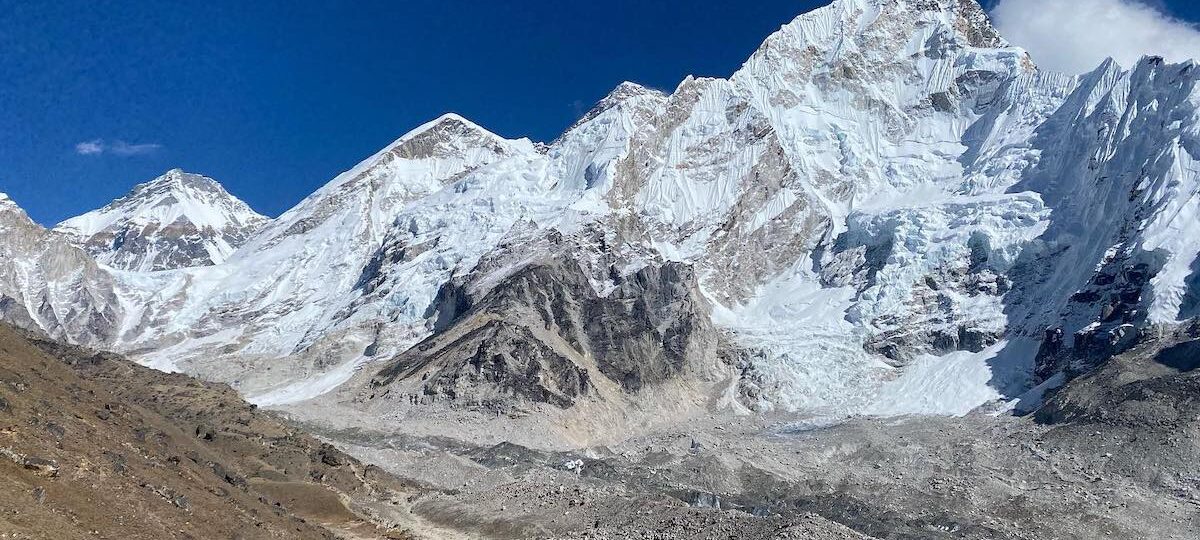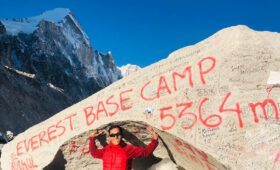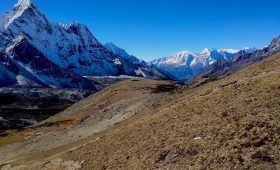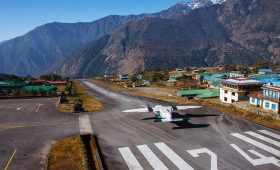Everest Base Camp trekking, the highest base camp trekking in the world takes you to the base of the tallest snow-clad mountain in the world, Mt. Everest (8,849 meters). Certainly, this epic and marvelous quest of the Himalayas leads you to the base of the highest point also known as the ‘Third Pole’, just 3,489 meters farther from the summit isn’t an easy feat. If you are here, then you might have decided to set out on this one-in-a-lifetime experience and wondering about the Everest Base Camp elevation points and how tough it actually is.
Well, rest assured, in this article we have covered all the Everest Base Camp elevation points and all the other related details regarding the Everest Base Camp Trek. So stick with us to learn more about his amazing Himalayan adventure.
Overview of Everest Base Camp Elevation Gain
Everest Base Camp Trek is one of the most popular trekking expeditions in the world, at the same time it is also a Himalayan adventure that leads you to the highest base camp in the world at the elevation of 5,360 meters (17,585 feet). Starting your adventure from a scenic flight to Lukla at 2,860 meters from Kathmandu (1,400 meters), you will continue to gradually push for the higher Everest Base Camp elevation points.
Moving along the ascending trail towards Namche (3,440 meters), you will end your second day’s adventure at an altitude close to 3,500 meters. Then, you will trek towards Tengboche (3,856 meters) making your way toward Dinboche (4,380 meters) crossing the 4,000-meter margin.
You will get acclimatization days during both Everest Base Camp elevation gain points after exceeding the threshold of the 3,000-meter and 4,000-meter. It is very crucial to acclimatize properly at the high-elevation jump points to minimize the risk of altitude sickness which also of course boosts the success rate. Proceeding further with your Himalayan expedition, you will push for Lobuche (4,938 meters) on Day 7 and finally reach the 5,000-meter elevation on Day 8 at Gorakshep.
The next part of the adventure can be quite challenging as you will spend a significant amount of time in altitudes over 5,000 meters. Making your way from Gorakshep (5,140 meters), you will conquer the Everest Base Camp at an elevation of 5,360 meters (17,585 feet) on this day, returning back to Goraskhep for the night stay.
Depending on the time at hand, you will either climb upto the highest Everest Base Camp elevation point, Kalapatthar at an altitude of 5,545 meters (18,195 feet), on either Day 8 or Day 9. If you hike upto Kalapatthar on Day 9, it will be for the epic sunrise view from this vantage point that offers spectacular views of the Khumbu region and the magnificent peaks in the Himalayas.
You will trek down to Pheriche (4,371 meters) after completing the hike then follow the gradual descending trails to the lower Everest Base Camp elevation points on the latter days like Namche Bazaar (3,440 meters), and Lukla (2,860 meters) before finally parting from Himalayan region to Kathmandu (1,400 meters).
General 12 Days Outline Itinerary With 2 Days Acclimatization Day
Here is a general 12-day Everest Base Camp Trek outline that will assist you further in understanding the day-to-day adventure as well as the Everest Base Camp elevation gain during each day of your adventure.
Day 1: Kathmandu to Lukla flight, trek to Phakding
Flight Time: 20 minutes
Altitude Gain: 1,460 meters
Trek Time: 3 hours
Starting your adventure from the capital city Kathmandu at the elevation 1,400 meters, you will head towards the gateway of the Everest region, Lukla at 2,860 meters. Then ending this day’s adventure you will slightly descend down to Phakding at 2,651 meters for an overnight stay.
Day 2: Phakding to Namche trek
Altitude Gain: 789 meters
Trek Time: 5 – 6 hours
On the second day of your trekking adventure, you will leave Phakding behind heading towards the Sherpa capital, Namche Bazaar at the elevation of 3,440 meters. There is quite the elevation gain on this day’s trek as you climb over an altitude of about 800 meters.
Day 3: Acclimatization and exploration day at Namche Bazaar
As you ascend to the region above 2,500 meters altitude, you will use this day to acclimatize to the high-altitude environment. The risk of catching altitude sickness for the human body starts at an altitude of over 2,500 meters.
Day 4: Namche Bazaar to Tengboche trekking
Altitude Gain: 416 meters
Trek Time: 5 hours
Moving along the ascending trek, you will climb upto the elevation of 3,856 meters at Tengboche on this day’s adventure. It’s an over moderate day’s adventure, a short trek and altitude gain below 500 meters, still trekking in the rising altitude will be tough.
Day 5: Tengboche to Dingboche
Altitude Gain: 524 meters
Trek Time: 4 – 5 hours
Leaving the Tengboche behind on this day’s adventure you will hit the 4,000-meter altitude margin as you follow the ascending route to Dingboche at an elevation of 4,380 meters. Shot trek still the toll of low oxygen saturation level at an altitude above 4,00 meters can be challenging, recommended to stay hydrated and enjoy a slow-paced adventure.
Day 6: Second acclimatization day at Dingboche
After climbing over the altitude of 4,000 meters, you will use this day as the second acclimatization to adapt to the high-altitude environment. Hiking and light physical activities are recommended as it is very helpful for an effective acclimatization process.
Day 7: Dingboche to Lobuche trek
Altitude Gain: 558 meters
Trek Time: 4- 5 hours
Trekking from Dingboche to Lobche is a challenging day’s adventure, heading toward the Thukla Pass at an elevation of 4,800 meters, you will push for the Lobuche at an altitude of 4,938 meters during the second part of the trek. Take it slow and stay hydrated throughout the trek, recommended to drink a minimum of 3- 4 liters of water.
Day 8: Trekking to Gorakshep to Everest Base Camp and return to Gorakshep
Altitude Gain: 422 meters
Trek Time: 6 hours
On the big day of the entire expedition, you will first head toward Gorakshep at an elevation of 5,140 meters, then after resting there for a bit, you will then push toward the Everest Base Camp at an elevation of 5,360 meters. As you will spend a lot of time at an altitude of over 5,000 meters, you need to pay proper heed to your health conditions and stay on the lookout for the symptoms of altitude sickness like nausea, fatigue, malaise, dizziness, insomnia, and headache.
Day 9: Gorakshep to Pheriche
Altitude Loss: 769 meters
Trek Time: 4 hours
Depending on yesterday’s adventure, if you didn’t hike upto Kalapatthar, the highest elevation point of this entire expedition at the altitude of 5,545 meters, you will do an early morning hike to Kalapatthar to enjoy the epic sunrise view. Then, you will get started on your descend trail from Gorakshep to Pheriche at an altitude of 4,371 meters.
Day 10: Trekking down to Namhce Bazaar from Pheriche
Altitude Loss: 931 meters
Trek Time: 6 hours
You will start enjoying trekking on the moderate trail as you trek down to the lower elevation point with the high oxygen saturation level. Trekking down from Pheriche to Namche Bazaar (3,440 meters), you will lose a significant altitude moving down on the descending trail.
Day 11: Namche Bazaar to Lukla
Altitude Loss: 580 meters
Trek Time: 6 – 7 hours
Concluding your Himalayan expedition, on this day’s trekking expedition, you will trek down all the way to the starting point of the Everest Base Camp Trek, Lukla, at an elevation of 2,860 meters. This will officially conclude your epic quest in the Himalayas as you move farther from the Everest Base Camp elevation points.
Day 12: Fly back to Kathmandu
Altitude Loss: 1,460
Flight Time: 20 minutes
Flying back from Lukla, on Day 12 you will land at the capital city of Kathmandu at an elevation of 1,400 meters. Moving away from the Himalayan region, this day’s elevation will feel normal as you get back to the standard altitude among all the Everest Base Camp elevation points.
Why You Should Not Go to a Higher Place Just in One Day?
Considering the trekking duration and the elevation point, you might be wondering, what if you were able to cover a significant altitude in a single day? From a certain perspective, it is a valid point, simply covering more distance if you are perfectly fit for the adventure means that the trek will be shorter and of course, comparatively cheaper than the longer itinerary day packages.
But, realistically, it is not as simple as it sounds, first you have to understand this is not just a high-altitude adventure but also a Himalayan expedition. This means you will be exposed to the alpine and colder climatic conditions, so the acclimatization process which is already difficult in a rushed adventure becomes more challenging in the cold region.
As there is a risk of catching altitude sickness above the altitude of 2,500 meters if you are rushing your adventure in a single day exerting yourself with the tiresome long day of adventure. There is a high chance that you will fall victim to altitude sickness and the Everest Base Camp Trek which is considered to be one of the reasonably facile adventures with a success rate of 95% to 97%, may start to seem like a far-fetched dream.
However, most importantly, you will be missing the entire of this fascinating Himalayan exploration. The trekking packages in Nepal are designed for a slow-paced, comfortable, and immersive experience, if you rush to the finish point like a marathon, you will most certainly not get the best value experience.
The itinerary plans, the acclimatization period, food and accommodation, break/lunch destination, cultural aspects, and the vantage points of this beautiful trekking experience are designed for the trekkers to truly immerse and relish the allurements of the Himalayan region without missing out on anything.
To sum it up with the quote “It is not all about the destination but about the journey that leads to your destination”.
How Much Altitude You Should Gain Per Day?
When trekking above the altitude of 2,500- 3,000 meters, it is recommended that you shouldn’t hike above the altitude of 500 meters per day. So, your everyday adventure should be based on this thumb rule that defines going over the 500-meter altitude gain point as risky.
You are also recommended to take acclimatization and rest days after ascending over an altitude of 1,000 meters so you don’t over-exert yourself and so that you will be able to properly acclimatize to the high elevation environment. But when talking about the Everest Base Camp elevation gain, does the general trekking package implicate this general minimum altitude gain on each day’s thumb rule?
The answer is Yes, the trekking packages for the Everest region are designed considering this standard minimum altitude gain per day rule. In most general conditions, you will be ascending only about 500 meters altitude during each day of your Everest Base Camp Trek.
The only instance it goes a little overboard the designated margin is during the Phakding to Namche trek which is close to 800 meter altitude gain. As you will be enjoying a slow-paced adventure slowly climbing the Sherpa capital it is a quite normal itinerary plan in the Everest Base Camp Trekking adventures, that is why there is always an acclimatization day right next to this day’s adventure.
As for the 1,000-meter altitude gain equals an acclimatizing rest day rule, you may not get the exact proportionate number of acclimatization days compared to the altitude gain. But, what you need to understand is the general rule for acclimatization is based on the exerting full day’s adventure, whereas, in the Everest Base Camp Trek, you will cover the trekking ground for just 5- 6 hours. So, taking these factors into consideration there is only a limited number of acclimatization days in the general Everest Base Camp Trekking packages as you will get enough time to acclimatize properly at every day’s rest points.
Overall Difficulty Factor of the Everest Base Camp Trek
After learning about the Everest Base Camp elevation gain, you might be wondering about the overall difficulty level of this epic Himalayan adventure. So, what is the true difficulty level of this highest best camp trekking adventure in the world considering the altitude gain and other difficulty factors of the trek?
Well, the Everest Base Camp Trek has been graded as a ‘Moderately Difficult’, which indicates that this is not a strenuous exploration like a Himalayan expedition which demands technical skills nor it is like an evening stroll to the park or a backyard hiking. Even though you don’t need any high-altitude trekking experience for this trek, you will still be required to make an adequate amount of preparation to make this Himalayan quest a truly enjoyable and memorable experience.
After talking about the Everest Base Camp elevation gain, let’s do some briefing about other difficulty factors of this trek.
Trekking Distance
During this beautiful Himalayan exploration to the heart of the Khumbu region, you will be covering an approximate trekking distance of 130 km (130 miles) in total including the trek back to start point Lukla. So, during the Everest Base Camp trekking you will cover an approximate trekking distance of 5 – 6 hours on average on the rugged remote trails.
From the surface, it may not seem like a big deal to trek for relatively shorter hours. But what you need to understand is this is completely on the off-beaten steep trails of the Himalayan region. Plus, you will be carrying your luggage in the gradually inclining route at the higher altitude which can take a toll on your body if you haven’t trained for the expedition.
Remoteness of the Trail
The Everest Base Camp Trek takes place in the remote isolated parts of the Himalayas which doesn’t even have a proper mode of transportation. Thus, the entire region depends on the flight services and transfer of goods with the help of porters, mules, and yaks, so you won’t find much technological and infrastructural development here.
The food and accommodation services along the trekking route are moderate to luxurious considering the quality of the teahouses and their services as it is one of the mainstream trekking routes in Nepal.
As for the medical facilities, there are only a limited number of health institutions along the trail, in case of an emergency you can only depend on the helicopter rescue. The same goes for internet, telephone services, and other amenities as well, the lower regions do provide adequate services whereas they are limited at the higher regions.
Weather Condition
The weather condition is very significant when it comes to an enjoyable and memorable adventure, doing the Everest Base Camp Trek during the peak seasons like spring (March to May) and autumn (September to November) is considered to be the most ideal. The weather is stable during these seasons, with pleasant temperatures, clear visibility, and dry trails making it a wonderful time for the Himalayan expedition.
On the contrary, if you were to do this trek during the off-seasons like winter (December to February) and monsoon (June to August), the stakes can be pretty high. You might not end up getting the best experience or catching the perfect glimpse of the Himalayas vistas during these seasons.
Both winter and monsoon are known as unfavorable months for the Himalayan adventure in the country. The wet trails, areas prone to landslide risks, and disruption in transportation can be a mood killer, whereas, the extremely harsh climatic conditions of the winter that cover even the trail with snow can be a challenging factor to overcome.
Khumbu Cough
Khumbu cough is a quite serious condition that trekkers catch after getting exposed to the dry air and cold climatic conditions of the Khumbu region, as you get closer to the Everest Base Camp. There can be several reasons behind this troublesome health condition like insufficient acclimatization, dehydration, low immune system in the long days of trekking, or due to lack of proper clothing.
However, once you catch Khumbu cough, it is really hard to shake off, sometimes it can last for weeks and months depending on the exposure level. So, the trekkers are recommended to acclimatize properly, stay hydrated, eat a healthy balanced diet, and bring warm convenient clothing.
Is This Trek for Me?
Everest Base Camp Trek is one of the most exciting and thrilling Himalayan adventures in the world, this beautiful Himalayan expedition is on the wishlist of every trekking enthusiast in the world. So, if you are considering this epic quest and wondering if it will be ideal for you or not, well it all boils down to the determination; how much you are willing to do to complete this trek.
In fact, if you are firmly determined to complete this trek, you will certainly put effort into the training period, stay motivated and positive, pay attention to every minor detail, and overall enjoy the overall experience because you really want to do it.
The Everest Base Camp trekking has been completed by elderly trekkers as old as 75 years old and even children below the age of 10. So, if you really wanna do this trek and are determined to overcome the face difficulty factors, you are certain to enjoy a truly exhilarating experience in this iconic Himalayan expedition.
A basic level of fitness with good health conditions is recommended for a comfortable and enjoyable adventure, in case if you have any medical conditions you should consult with your physician and guide about the expedition. As for the preparation period, you are recommended to trail at least 6 – 8 weeks prior to the trek so your body will get accustomed to the physical activity.
Note: Hiking on natural trails carrying a backpack with significant weight is recommended for the identical stimulation of the actual trekking adventure.
Do you have any question about trip to Nepal?
Tell us about your trip to Nepal and what you expect from it. We will answer your questions in 24 hours and help you design a trip with a comfortable itinerary to best meet your needs.





